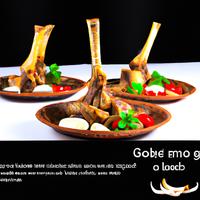
1 serving (100 grams) contains 215 calories, 18.0 grams of protein, 16.0 grams of fat, and 0.0 grams of carbohydrates.

Log this food in SnapCalorie

Nutrition Information
Calories |
511.9 | ||
|---|---|---|---|
% Daily Value* |
|||
| Total Fat | 38.1 g | 48% | |
| Saturated Fat | 16.7 g | 83% | |
| Polyunsaturated Fat | 0 g | ||
| Cholesterol | 166.7 mg | 55% | |
| Sodium | 166.7 mg | 7% | |
| Total Carbohydrates | 0 g | 0% | |
| Dietary Fiber | 0 g | 0% | |
| Sugars | 0 g | ||
| protein | 42.9 g | 85% | |
| Vitamin D | 0 mcg | 0% | |
| Calcium | 23.8 mg | 1% | |
| Iron | 3.6 mg | 20% | |
| Potassium | 476.2 mg | 10% | |
* Percent Daily Values are based on a 2,000 calorie diet. Your daily values may be higher or lower depending on your calorie needs.
Food Attributes
Source of Calories
About Lamb bone
Lamb bones are a nutrient-rich ingredient often utilized in broths, soups, and stews, celebrated in cuisines such as Middle Eastern, Greek, and Indian cooking. These dense, marrow-filled bones are rich in collagen, which supports joint health and skin elasticity, as well as essential minerals like calcium, phosphorus, and magnesium that contribute to bone strength. Slow simmering releases gelatin, making lamb bone broth a soothing, nutrient-dense base for various recipes. While lamb bones themselves are not consumed directly, the marrow within is a source of healthy fats and vitamins. However, lamb can be higher in saturated fat compared to some other proteins, so moderation is key if dietary fat is a concern. Choosing ethically sourced lamb ensures quality, both nutritionally and environmentally, making lamb bones a flavorful and functional addition to diverse culinary applications.



